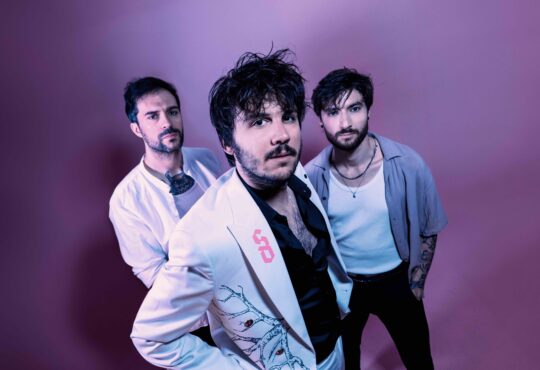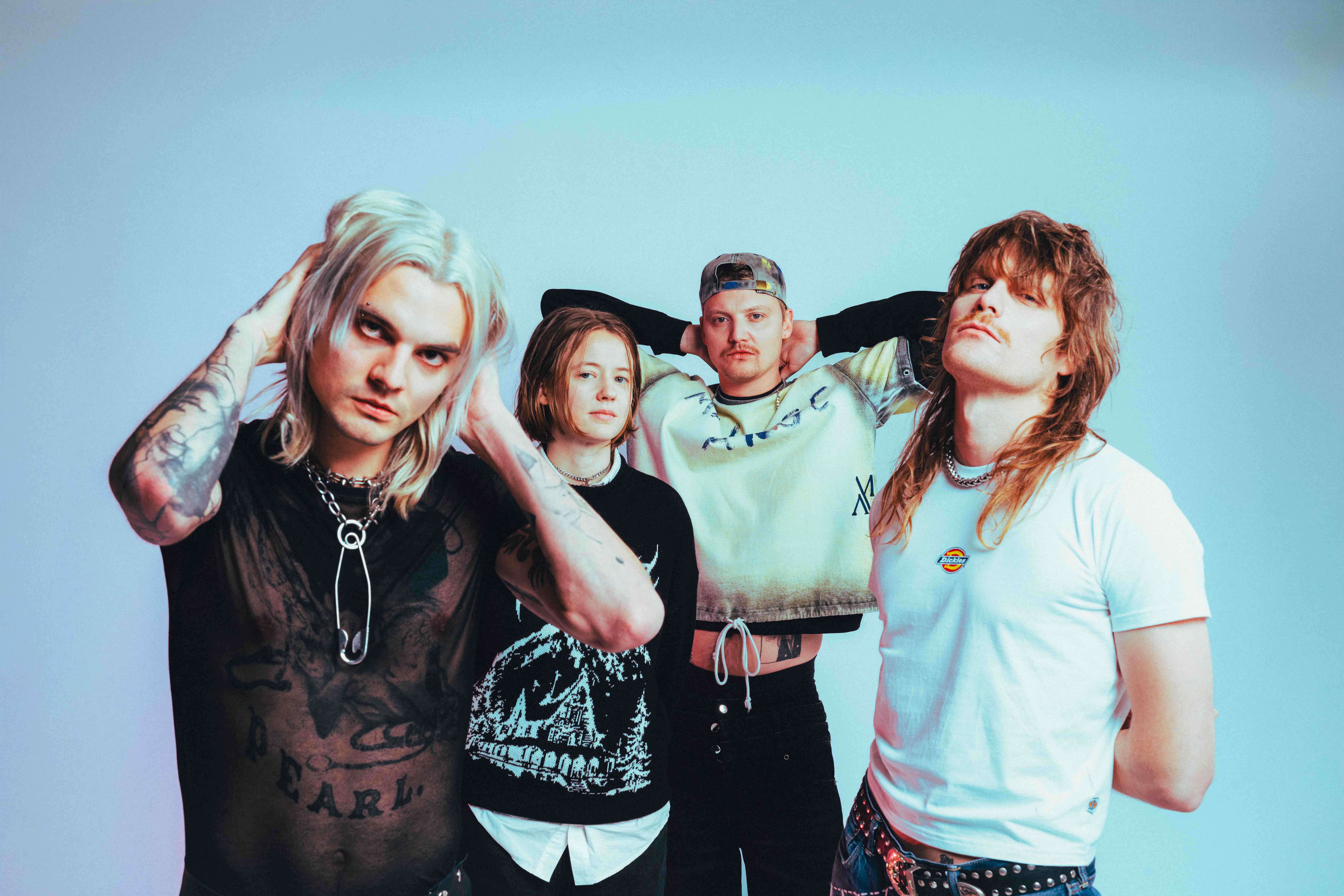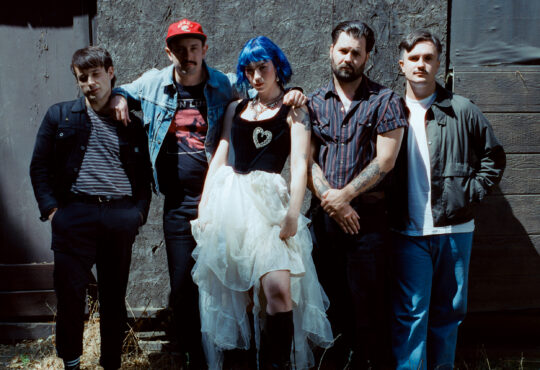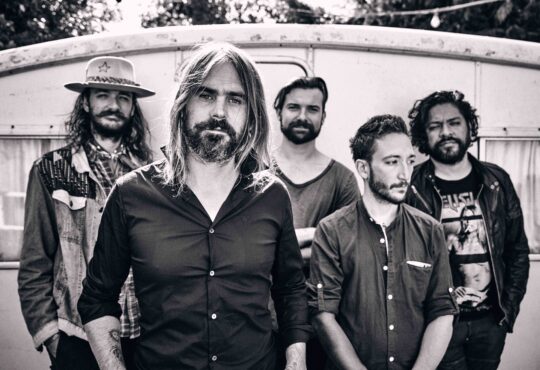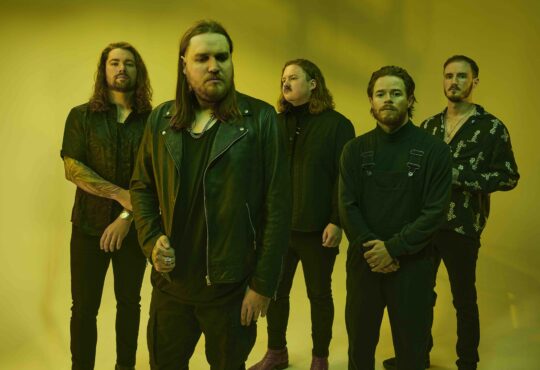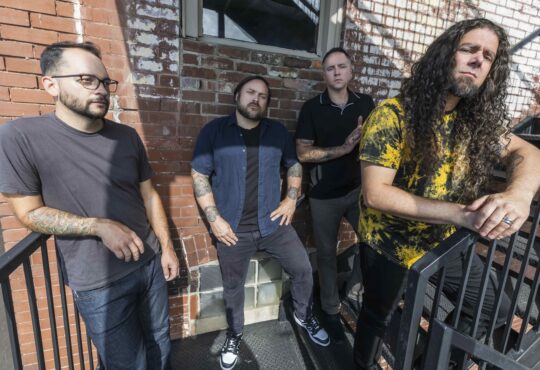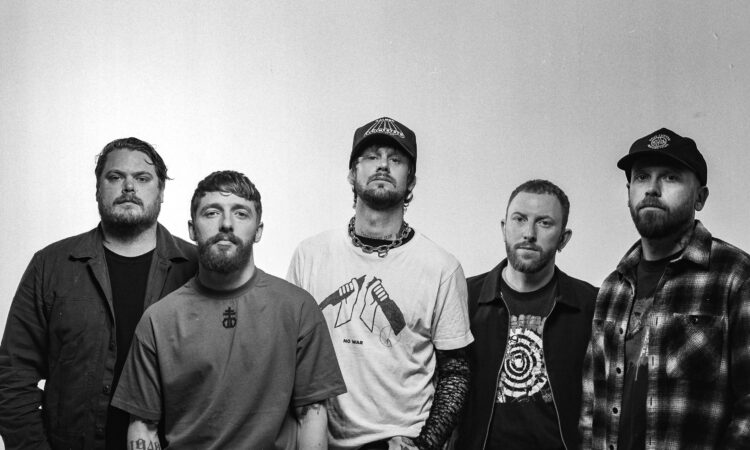
Few days before the release of While She Sleeps‘ new album SELF HELL, RockUrLife had the chance to chat with guitar player Mat Welsh. A nice opportunity to find out more about the band and its views on the music industry.
You’re just on the verge of releasing a new record, and you know this record SELF HELL very well because you’ve been working on it for the past years, but for the public, it’s brand new. So, how do you feel? Are you excited about it?
Mat Welsh (guitar): I think at this point in the process, this period is really exciting because when you finish the record, it’s so far away from the release that you just feel like you have this sort of secret to keep for ages and this thing that you just can’t share. But when you get to this point, it’s like we’re a month away from release. I want to start showing people bits of it and I’m not. Instead of that, it’s really scientific at the beginning, and you’re choosing what song you want to share with people and what sections you want to give to people. And at this point, the public has had three songs, and people are feeling that momentum of it being so close to release. People are pre-ordering the record, and it’s becoming quite an interactive time. So, it’s the funniest part in it really because we can see the finish line and we know that the record is going to be out in a month. So, it’s probably the most exciting part of the campaign. It’s my favorite bit really. I like it at this point.
You released three songs for sure. They are very different, and the band is known for the energetic, punk, heavy metal breakdowns, melodic vocals. But now you’re pushing the boundaries of your music even further like a lot more electronic sounds, synthwave, symphonic sounds. How do you balance these diverse elements to maintain the cohesive sound?
Mat: I think we’ve always tried to go into the studio with a very open mind to what we make. We don’t really discuss or decide what we’re going to make before we go into the studio. It’s more a case of going in and just seeing what, just all personally writing and seeing what comes because that’s the best way to get a true representation of us as people. And we always try and have no boundaries at all about what it’s going to be, what instrument or thing it’s played on. So, we did that on this one and this is just kind of the way it’s gone. But I’ve always kept in mind that as long as we don’t imitate anyone else and we don’t try and sound like anyone and we use our natural voices to sing and the guitars that we’ve always played and those sounds and those things, if we keep the elements the same, then what you can do musically is limitless as long as you perform them as you. So, I think that’s potentially why we have that sort of flexibility to try so many things but always hopefully sound like Sleeps is because it’s still coming out the same voice, you know?
The vocal range keeps getting bigger and bigger and bigger. You have this rap element from “Leave Me Alone,” this growling intensity on “Down,” it’s just amazing how much level of vocals you have.
Mat: Again, that’s just being open to the influences. I listen to loads of rap, and I think that’s probably the most influential music that I have in terms of makes me want to write lyrics and create interesting timings and it’s the most active form of poetry I think rap is. It’s expressive and interesting. So, yeah, that’s just not having the boundaries up, really.
The record starts with “Leave Me Alone,” where you have this rap vocals that are very fluid and a poppy chorus before everything just explodes. You managed to blend everything to make something that really sounds like you.
Mat: Right, yeah, and hopefully it just keeps you on your toes. I like the idea that you could say, I think I know what’s coming next and then what comes next isn’t what you expect. When that happens to me in music, that’s my favorite feeling. The “when I get caught out.”
Then you have “Rainbows” with these sinister guitar riffs that are vibrant at the same time. It’s very disconcerting and pleasing.
Mat: I like that description of it, it’s cool.
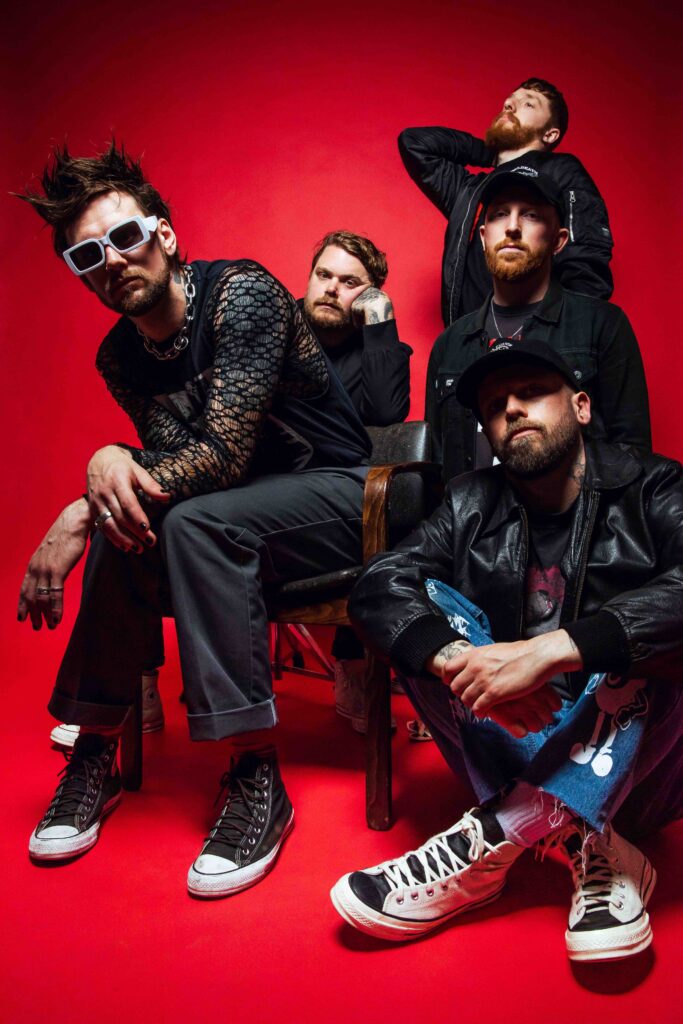
The further you get into the record, the more it surprises you. For example, the eponym title, “Self Hell,” has a strong 90’s vibe. The chorus almost sounds like Limp Bizkit. It conveys a nostalgic feeling for all the 90’s kids!
Mat: Yeah, I think that’s where a lot of that song is that influence and the same, the chorus has a slightly nostalgic english britpop feel to it, which is, again, that’s the music that was surrounding us when we were growing up. That like Manchester, sort of Kasabian almost, like britpop sort of thing that is buried in there somewhere. I like that it had that feeling with it.
The video is just great. You managed to create the perfect adequation between the song and the visual aspect of it.
Mat: We tried to really just have fun with that video and try and not take ourselves too seriously. The brief was like, let’s make a 90s pop video but in our own style to this song and just see how it. Essentially, dress the song up in a different set of clothes than you would have heard it in, if you know what I mean. And it worked, really. When people heard the song and watched the video, I think the video made them more surprised by the song than if we’d have been stood in a murky warehouse playing that song. Then I don’t think people would have said the song is so different. But because the video was so colorful and so vibrant, everyone was like, they’ve gone pop. And it’s like, nah, no, we haven’t.
No, but you embraced the fun of it. And I think it highlights the lyrics as well.
Mat: Yeah, exactly. That’s the point, yeah. It was very interesting.
The videos that you’re making are generally so creative, they are unique and original, like what you did for “Down.” That’s something that really blew our minds. How did you get this idea?
Mat: Good, thank you. It’s very, very complicated. I’ve got a massive obsession with physical art. So, drawing things on physical things, then taking a photo of them. You can probably see it with a lot of Sleeps. We like physical things. So, the cover for Brainwashed, for example, is like we painted a flag and then we put the flag somewhere. And same with Sleep Society, we were like, let’s make this banner physical.
And SELF HELL, the cover is a real thing. It’s got life inside it and a story of its own. And I’ve always liked quite those kinds of techniques of like, I have no interest in watching a lyric video come up on a digital-made lyric video. It doesn’t really feel like it has much personality inside it and those kinds of things. But we had no budget for the video, mainly because SELF HELL was so flamboyant and we spent quite a lot of money on it, even though we still did it ourselves. This one, I was like, what could we do that doesn’t cost anything but will have loads of interest in it? So, I was like, well, let’s do a lyric video, but let’s do it in photos so it’s got our character embedded within it and it’s physical and you’re watching the lyrics come up so that there’s an element of like, how did you do that? And then had this idea of almost what it looks like when you have like a photo booth on a night out and it’s like telling this story of all these different things that happen in this tiny little box of space and integrating those two ideas.

I just bought a lens off a disposable camera. So, people take disposable cameras apart and use the lens on a digital camera so you can keep that feeling of like a disposable camera or a photo booth. And then just went into the project and started working out how we could do it sort of in time with the music so that we could film a short clip, then stop, then I would go and paint the back wall and then perform the bit that syncs with that, then stop again and paint the back wall.
And then on the next section, I wanted to go back to a different color or these things. So, it was just a real, all the ideas in it just came from us just sat there brainstorming, going on what would look interesting in this setting, in this photo booth. Yeah, and it was really fun, very complicated and lots of mathematics involved. But I think it’s all about just trying to make something that the viewer spends a moment longer on and looks at and goes, wow, how did you make that? We know that anything’s possible on a computer. We know that you can get AI to do anything you want now. But we’ve gone so far in that direction that I’m not interested anymore in how good the graphics can look or how fake you can make something. I want to see something physical. I want to see the opposite end of the spectrum and see what a human can do with a cool idea in a little box. And yeah, that was that. It’s just about trying to be the opposite end of the spectrum to the AI world.
When you’re watching it at some point, you just forget that it’s not a video because the movement is so fluid, you know? And then you just stop for a moment because you need to focus your attention on some word, on some scene. So, it’s very, very well done for this as well because the rhythm perfectly matches the song.
Mat: I’m trying to make it into a book so that you can physically play the song and get it so that you can flick the book in time with the song on. Then you’ve got this physical video, which would be quite a cool thing to own. It would be so cool.
You kept going on and made another video that’s just very, very emotional and that’s just so different and so radical. It fits the song because it has all this rage, this passion and nostalgia. It’s quite overwhelming. How did you come up with such a song?
Mat: I think the song just is a very natural creation in the studio. We’ve always loved that melodic side, and there’s always been a bit of that in our albums. We listen to a lot of music like that, so we like to not ignore that fact and go into these big, sort of, quite more melodic journeys that are a bit more emotional. And the song happened naturally, and we always had a really nice feeling every time we were working on it in the studio.
It felt quiet, like, epic and, like, powerful. And then with the video, it was just a case of, well, obviously we sort of chose that song because everyone we showed it to and every time, we put it on, we felt just something cool and powerful. It felt important to show that as well as everything else we were doing because it leaves people quite unknown of what the record’s going to be. Like, listening to “Self Hell,” “Down,” and then “To The Flowers,” you’re like, I don’t really know where this record’s going to go. Is it going to be, like, are they getting softer? Are they getting heavier? Like, what’s the mood? And we really wanted to leave that door open. I don’t want to tell everyone exactly what it’s like. I want you to listen to the record and then work it out for yourself. And so that song just felt important to release because of the way we felt every time we listened to it. And then the video, I just wanted to make something again that we hadn’t made yet in this releasing process. Let’s go to the opposite end of the spectrum to where we were with “Down” and where we were with “Self Hell.” And I’m a bit, like, I’m quite bored of seeing the band in the video performing. That’s what you should go to a gig for. That’s what you should see us do live. In some moments, I think a performance video is great, but I just wanted us to exercise a bit more creativity and do something slightly more interesting. And Aaron, the bass player in the band, he’s making films as a hobby, basically, and there’s another profession on the side. And I just was like, why aren’t we harnessing this skill? And why aren’t we just using this thing to make something powerful? If we think the song’s powerful, let’s tell a story in it and let’s do something like that. And that just opened a whole new doorway into us going, okay, sick. Let’s turn into a film crew and let’s just pretend that’s what we’re doing for the next month and do it. And let’s make a short film and try and paint a picture that maybe the feeling the song gives to you, let’s try and do that in the visuals as well. So, it’s this one thing together. Yeah, and that’s how we got there. I’m happy with how it came out.
It’s such a challenge in four minutes to have something that is tragic but realistic, with lots of different emotions like grief, love, and pain. It’s a real challenge because you don’t really have time to build your character.
Mat: Yeah, to try and do that with no words, with no spoken line from the actors and to try and tell a story in that amount of time is very difficult for sure. So, I was like, that was the real challenge. And shooting it to try and make it look like you’ve shot the story of someone’s life. It took us like over two weeks of filming every day to make that. And normally bands take a day to make their music video.
But you don’t do anything normally. The moment you decided to finance and do everything by yourself you changed your relationship with your music and band. You’re involved in every single aspect of your music, visually, musically, lyrically. How do you keep your relationship within the band with this amount of pressure and this amount of work?
Mat: It’s a constant learning curve, I think. I’m still navigating how to be both sides, be a musician and be involved in playing and writing and those things and the creative, but then also be involved with the business side of it and how does it happen? How do we pay the rent? How do we get there? All the logistics and those kinds of things. But I’ve always just been under the mind frame of if you care about something this much, then I want to know every single thing that’s going on inside it and I want to be in control of it because I don’t like this idea of I’ve dedicated the majority of my life to this project and I want to know that’s in the safest pair of hands possible.
That is keeping it inside. The music industry is an interesting place. I want to prove that you can make a successful career out of something that is quite hard to make a career out of for the next generation of artists and those kinds of things and present a different way of doing things so that hopefully other bands might decide to be more independent. When we were kids, we thought it was all about getting signed to a label and getting a management and then that was it. They’d do all the work and we’d just be the band and it’s the opposite to that. It’s all about it being internal and changing the model. A lot of balance to try and navigate those things but we’re getting there.
Speaking of balance, how do you feel a song like “No Feeling Is Final” integrate into the overall structure and theme of the album?
Mat: We worked with an artist called Aether on that who’s a Canadian artist. We listen to a lot of music like that. For me, my most listened to music is ambience and lo-fi and quite relaxing, long, slow pieces of music that you can use to be productive to and to work to. We always do this on the albums where if we’re going to shout in your face for 45 minutes and all this information, all these lyrics, all these lead parts, all this quite fast-paced overload of music, then I think it’s important that we put in these breaks. It’s almost like it’s supposed to be a palate cleanser. I don’t know what that would be in France. Like a break in between courses of your meal to just go, what does the next one taste like? I must take a second and reset a little bit. Otherwise, I sometimes think with heavy music, if you’re trying to listen to a full record of it and the dynamic is always 100%, then it starts blurring into sounding quite similar. I always like to try and tone it all down and change the dynamics so that you don’t get that feeling. I think it’s very interesting for us as listeners, for sure. I thought it was interesting as well for you.
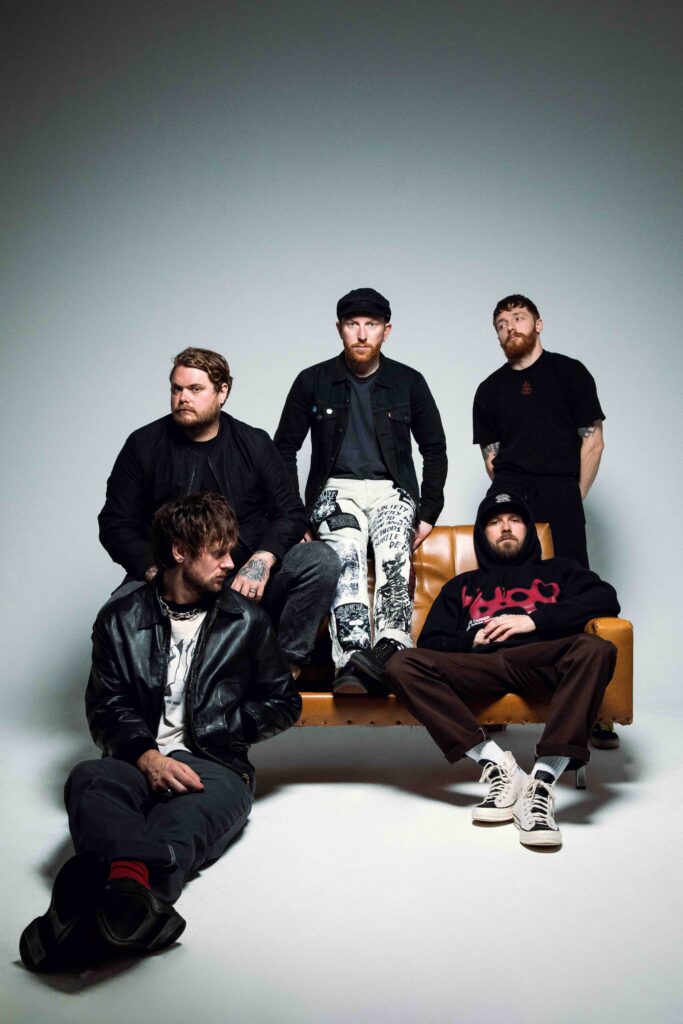
You do everything by yourself, but you still take a chance working with other people, other artists, which is not something that everybody is ready to do because sometimes you feel like you’re losing your identity when you’re working with someone else. But you did lots and lots of songs with other artists. How did you choose these ones for this record?
Mat: I think we like doing this now and we’re starting to try and be less possessive over the songs and the idea of collaborating because we already do enough, I think, for you to know that it sleeps and you know what you just said then, that we try and do things in a different way and the band is quite independent. So, I think it’s important that we always collaborate so it’s not just this and only this. I think we’ve got to have that outside world joining into these little sleeps world that we could quite easily get lost in. And we always just wait until we hear a section and think, oh, that would suit so-and-so, or does that almost make me think of that artist? Like Alex on “Down,” that’s just a collaboration because we’ve known each other forever and they live up the road from us. They’re in the same area. So, we just felt like it’s a nice community kind of feeling to involve your next-door neighbour, almost. Aether is just an artist that we’ve been talking to for years and we like his solo stuff. He’s an amazing, I listen to him all the time just at home and in the office. And then Stone, Finn, who’s on “Dopesick,” I just liked the sound of that band. And if you listen to their band, they are ultimate nostalgia. They sound like Manchester in the 90s. It’s this mix of Ian Brown and that whole Kasabian, Oasis, The Stone Roses kind of britpop. They’re doing that and they’re young and exciting. And I just heard the band, and I was like, who’s this? This is the vibe I’m kind of enjoying now. And I just reached out just on Instagram to him, and he was like, oh, dude, I’d absolutely love to come and do a song. And then he just came to the warehouse a couple of weeks later and we just spent the whole day with him just trying different ideas over the song and trying to just be less precious about it and make it that you can get stuck if you never look outside the box. We know now that Sleeps sounds like Sleeps does. And although we feel very much like we can do anything, we also know what we’re physically capable of with our own voices and with our own sort of musical abilities. So, it’s just nice to have someone else come in and do their thing on it.
What’s the “enemy mentality” you’re talking about in the song?
Mat: That’s a good question because that’s my lyric. I watch people begin their relationships with people they don’t know and think that the other person is out to get them. So instead of me and you speaking over this interview normally and interested, I would think that you want to get something from me, or you want to win something over for your own personal gain or thinking that everyone is out to get you. And I see people start relationships with other people like that. And I just think it’s such an unhealthy way to behave if you look at the rest of the world like they’re the enemy. Then that’s going to get you nowhere and it’s going to be a bad way.
But I watch so many people are afraid to ask a stranger a question or who don’t want to ask something because they think that they’re going to look stupid, or they think the other person is unsafe. It’s the idea if you think I don’t want to walk home at night because everyone who’s out at nighttime is evil and is going to get me, then no one will do that anymore and then we’ll all be afraid of something. There are bad things out there, but we can’t live like everything’s a bad thing.
So yeah, I watch it happen and that mentality of everyone’s the enemy is just such an unhealthy way to live. Yeah, that’s kind of what that means. So that was you.
Last question: our media is called RockUrLife. So what rocks your life, Mat?
Mat: Being a musician in a band like While She Sleeps, creating new music and touring. That rocks my life!
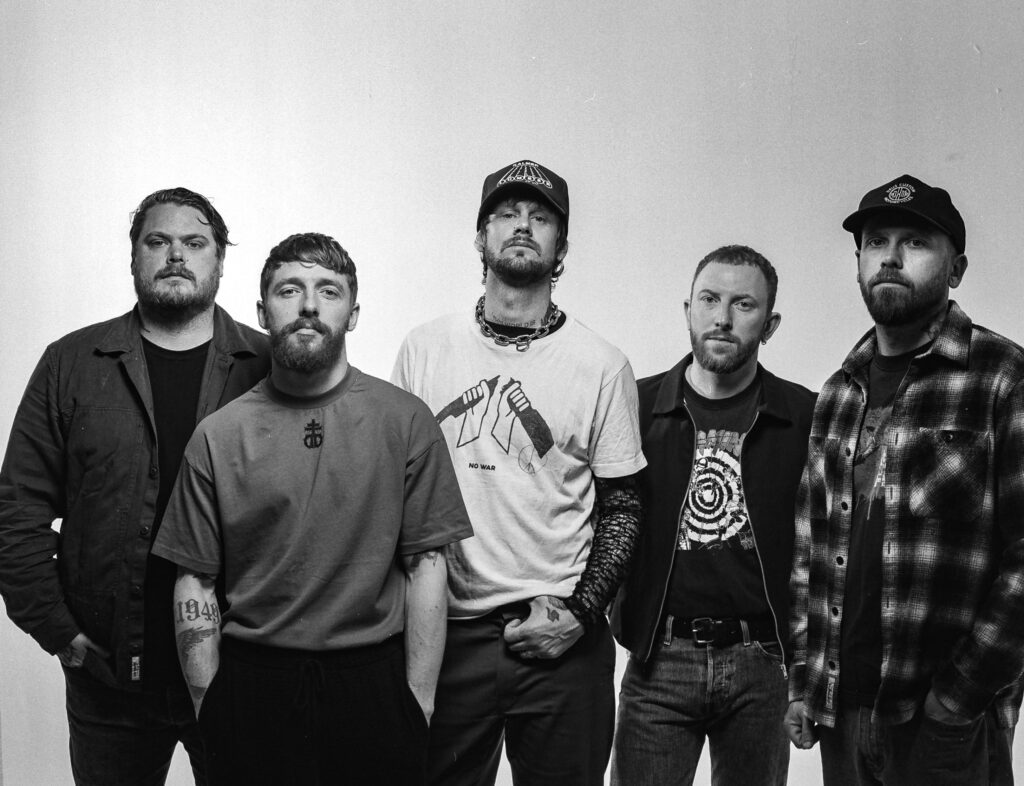
Website: whileshesleeps.com



